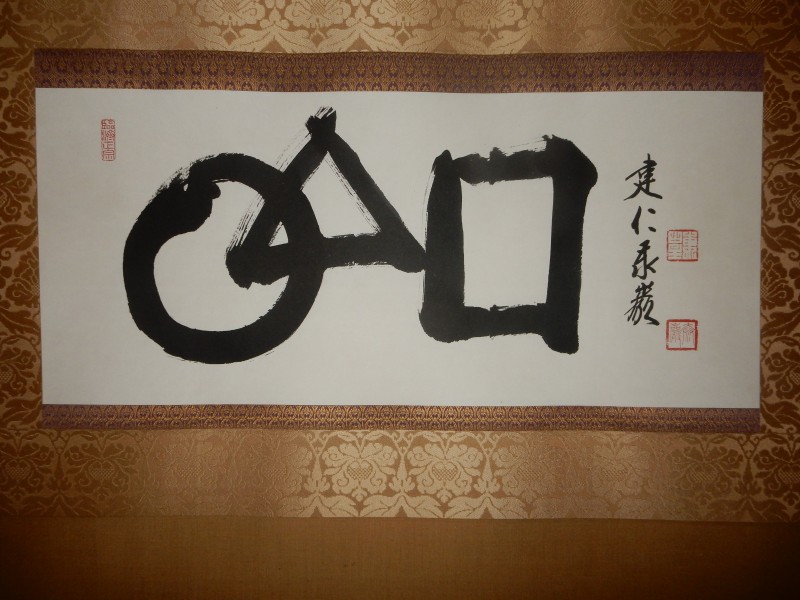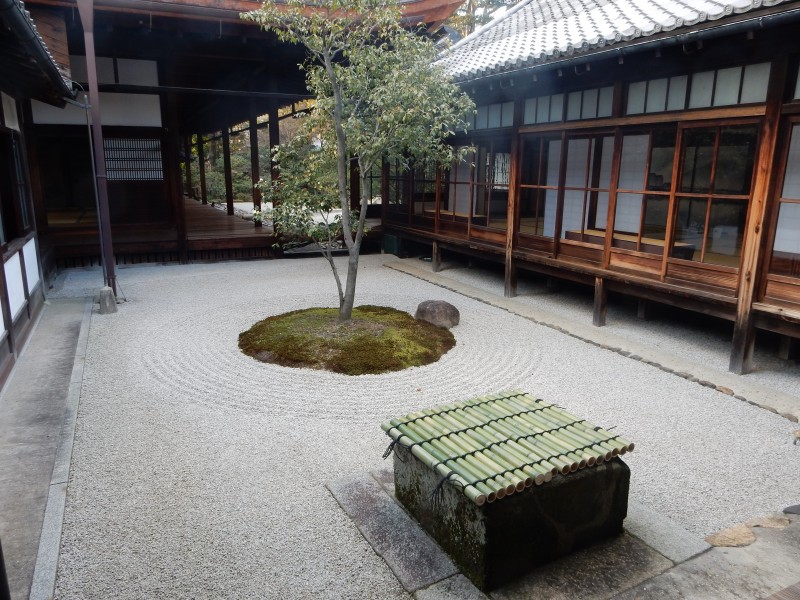
Zen painting at Kennin-ji
Three basic shapes beloved of humans, no doubt for their simplicity, are the square, circle and triangle. “Man is symbolized by three elements, one on top of another: pyramid—square— circle,” said Zoroaster.
In his book Kami no Michi Yukitaka Yamamoto, the 96th hereditary priest of Tsubaki Shrine in Mie Prefecture, wrote: “The Principle of ‘Sanmi–Sangen‘ explains the mystery of life. Sanmi–Sangen means the three elements that constitute the basis of all forms of existence. These basic symbols both explain the meaning of and guide the destiny of human life. We can see Sanmi–Sangen operate at many levels.”
I’m unable to identify where the Sanmi-Sangen theory originated from, but the founder of aikido, Ueshiba Morihei, put forward similar ideas:
“The body should be triangular, the mind circular. The triangle represents the generation of energy and is the most stable physical posture. The circle symbolizes serenity and perfection, the source of unlimited techniques. The square stands for solidity, the basis of applied control.”
If you check out this page, you can see all kinds of attributes have been allocated to the three shapes, including (oddly to my mind) the suggestion that the square stands for the Sun God Amaterasu, the circle for the Moon God Tsukuyomi no Mikoto, and the triangle for the God of the Stars, Susanoo-no-Mikoto.

Interestingly, a garden in the Zen monastery of Kennin-ji claims to be based on the square, circle, triangle motif. An accompanying notice says it is based on work by Sengai Gibon (1750 – 1837) [see left]. “One of his famous paintings,” says Wikipedia, “shows a circle, a square and a triangle. Sengai left the painting without a title or inscription (save for his signature), however the painting is often called “The Universe” when referred to in English.”
The painting has long puzzled people. The ink tones vary from grey to black, and the three shapes overlap as if to suggest interconnection between them. D.T. Suzuki, who introduced Zen to the West, interpreted Sengai’s painting to represent formlessness and infinity, in accord with his view of emptiness as the essence of enlightenment. (See here for his interpretation.)
So it would appear that Ueshiba took his idea from Zen. And when you look closer at Ueshiba’s thought, it is striking how close to the thinking of Zen it is. Suppress the ego. Discipline your mind. Understand the oneness of all things. Get back to basic purity (or in Zen terms Buddha nature).
It’s often said that Ueshiba derived his thinking from Omoto-kyo. I can’t help feeling that, as with other martial arts, Zen was a strong influence too. Or perhaps it’s simply the case that in the strongly syncretic world of Japanese religion it’s sometimes impossible to separate the strands.

The square, triangle, circle garden at Kennin-ji. While the circle and square are evident, the triangle consists of a wedge at the far end made out of a raised bed of raked gravel (barely visible here).

Dear Mister,
These three figures are most likely to stem from Mikkyo (and india) where the square represents earth, the circle represents water and the triangle the fire. If you add a semi circle for the wind and a jewel at the top you get a Gorintô which a basis for “Yoga” in Shingon, Tendai and maybe Shugendo. Zen in japan was founded by former Tendai Monks (as for Pure land sects) and for nearly a thousand years, until Edo period Shinto and Esoteric Buddhism where deeply intermingled.
Faithfully yours.
Excellent input! Thank you very much for those thoughts, and for suggesting a Mikkyo and Indian provenance…
The square, triangle and circle have been used since ancient times in the patterns called kolam or rangoli which Indians draw outside our doors. A practice that continues to this day in most households.
But having read your post and comment I thought there is probably a stronger connection with the Yantras which are tools for meditation or realisation. They are geometric patterns which are supposed to be as powerful as mantras in invoking specific energies.
For example we have a specific yantras for Saraswati, the goddess of learning or Laxmi the goddess of wealth and so on.
In a yantra, the square represents the earth or finite boundary, the triangle is fire or creative energy and the circle represents air or ether.
Corresponds quiet nicely to the painting called ‘The Universe’ does it not? Man or creation placed between earth and space. A snapshot of the universe.
Many thanks for the input, Anu. I looked into a site about Yantra power symbols and found that the triangle, circle and square were significant Vedic forms which symbolised spirituality, evolution and the earth. It does indeed suggest that the roots of ‘the universe’ idea lie in ancient India…
Incidentally, I came across a passage in Lafcadio Hearn where he writes of a poem attributed to the famous poetess Chiyo. “Having been challenged to make a poem of seventeen syllables referring to a square, a triangle, and a circle, she is said to have immediately responded,- Kaya no te wo Hitotsu hazushite, Tsuki-mi kana! -“Detaching one corner of the mosquito-net, lo! I behold the moon!” The top of the mosquito-net, suspended by cords at each of its four corners, represents the square;-letting down the net at one corner converts the square into a triangle;-and the moon represents the circle.”
John,
Could you please provide your source for that quote from Ueshiba?
Many thanks,
C
The circle is emptiness, the square form, the triangle combines them, as with the Heart Sutra’s phrase “Form is emptiness, emptiness is form”.
The same 3 symbols also occur as a representation of the Tarot, the circle is the Fool (Wild card), the triangle is the 21 trumps of the major arcana & the square is the 4 suits of the minor arcana. In “John Dee’s Occultism Magical Exaltation Through Powerful Signs” by Gyorgy E. Szonyi there is an analysis of the symbol & its occurance in Western Esotericism.
Thank you, that’s quite fascinating…